Despite his social and cultural advancements, Kublai Khan couldn't conquer like his grandfather had and his military failures would ultimately usher in the end to the Mongol Dynasty.
“Conquering the world on horseback is easy; it is dismounting and governing that is hard.”
These were the words of one of history’s most notorious conquerors, the Mongol ruler Genghis Khan, and it would be his grandson, Kublai Khan, who would accomplish just that when he successfully established the dynasty that would become the Chinese Empire — for a time, at least.
Kublai Khan is considered to be one of the greatest of the Mongol rulers — and initially because it appeared he had broken his grandfather’s legacy of conquering through force. He was the catalyst for many advancements both social and scientific and was considered a diplomatic Mongol.
But ultimately, Kublai Khan would come to model his self-image after those ambitious ways of his grandfather and this would undo him.
The Mongol Empire Before Kublai Khan

Wikimedia CommonsGenghis Khan, the “Khan of Khans,” a ruler himself ruled by the need to conquer, passed this ambition on to his grandson.
The Mongol Empire was born when Kublai’s grandfather Temüjin, best known to posterity as Genghis Khan, united the disparate tribes of the Mongolian steppe and unleashed them in wars of conquest starting in 1206.
The Mongols were adept cavalrymen and masters of the bow and were thus efficient dominators. The Mongols had the brain behind the brawn to match: Genghis Khan was a genius in ruthlessness.
“I am the flail of god,” Genghis Khan once declared. “Had you not created great sins, god would not have sent a punishment like me upon you.”
The expansion of the Mongol empire was genocidal in nature. By some estimates, 40 million people or 11 percent of the world’s population were killed in these conquests, and consequently, Genghis Khan became the Great Khan of Khans and ruler of the largest contiguous land empire in human history.
And it was this epic family legacy that Kublai Khan would inherit.
Kublai Khan’s Early Years
Kublai Khan was born on Sept. 23, 1215, as the fourth son of Tolui, the youngest son of Genghis Khan and a Nestorian Christian, Sorkhotani Beki, who was a princess of the Kereyid tribal people.
At the time of his birth, the Mongol Empire was already immense and spanned from the Pacific Ocean to the Caspian Sea. Kublai Khan was raised in the Mongolian traditions, learning to ride and hunt on the open steppe.
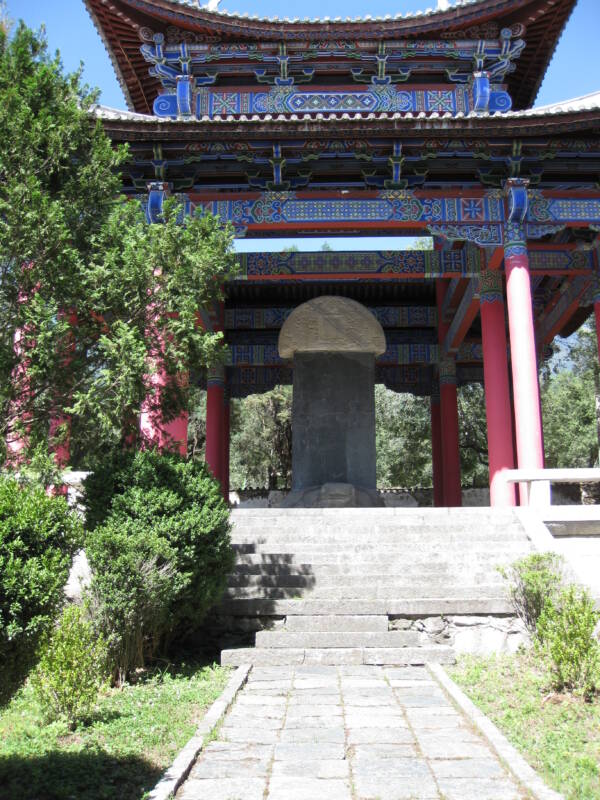
Wikimedia CommonsThis stone tablet was erected by Kublai Khan to commemorate his early conquest of Yunnan.
When Genghis Khan died on Aug. 18, 1227, Kublai Khan’s uncle Ogedei was given the title of Khagan, or “Great Khan.”
Ogedei elevated his brother Tolui by granting him lands in the newly conquered Jin Dynasty of Northern China. Kublai Khan himself received his first fief in 1234 which consisted of Hebei with 10,000 households.
As a new feudal lord, Kublai helped to stabilize and revitalize his province’s economy by lowering taxes and replaced some of his own Mongol advisers with Chinese ones. This was significant in part because the Mongol Empire was generally viewed by the Chinese as uncivilized barbarians. Kublai Khan, therefore, began to bridge their cultures from the start of his political career.
Kublai Khan also married several wives throughout his life, but his favorite was his second wife, Chabi. She acted as his unofficial adviser throughout most of his reign.
Ogedei ruled until 1241 when upon his death, the throne passed to his son Güyük, who died in 1248, and then to Kublai Kha’s older brother Möngke.
Möngke made Kublai Khan the viceroy of Northern China. In this position, the Khagan commanded Kublai to attack Yunnan and the kingdom of Dali in 1253. This was Kublai’s first military campaign which he successfully accomplished in three years.
Kublai Khan Establishes Xanadu

UNESCOAll that remains of Kublai Khan’s epic city of Xanadu, or Shangdu, today.
Fresh from his victories, Kublai Khan asked his Chinese advisors to select a site for a new capital based on feng shui. Then new capital was built between 1256 to 1259 named Shangdu or Xanadu.
Located in Inner Mongolia in modern-day China, the city was designed by Liu Bingzhdong, one of Kublai Khan’s Chinese advisers.
The city incorporated Chinese architectural elements as well as Mongol nomadic traditions. The city took up 25,000 hectares on a plain and over 100,000 people came to live there and operated as the capital of Kublai Khan’s growing Chinese Dynasty until he moved it in 1271.
The city had three separate enclosures: The Inner Palace which was surrounded by the Imperial City and then the outer city itself. Not forgetting the Mongol way of life, Kublai Khan built a garden to the north of the city which was used as hunting grounds. He would travel there at least once a week.
The Venetian traveler Marco Polo described Kublai’s palace as “admirable” and marveled at the craftsmanship of the great palace.
The city was described in the famous poem by Samuel Taylor Coleridge titled, “Kublai Khan.”
In Xanadu did Kubla Khan
A stately pleasure-dome decree:
Where Alph, the sacred river, ran
Through caverns measureless to man
Down to a sunless sea.
So twice five miles of fertile ground
With walls and towers were girdled round;
And there were gardens bright with sinuous rills,
Where blossomed many an incense-bearing tree;
And here were forests ancient as the hills,
Enfolding sunny spots of greenery.
Today, Xanadu exists as ruins which were designated as a UNESCO World Heritage site in 2012.
Becoming Khagan And Beginning A Civil War

Leemage/Corbis via Getty Images, from the 15th-century book, The Book of the Marvels of the World.”Kublai Khan’s palace, the remains of which are in present-day Beijing, was once hailed by explorer Marco Polo as “the greatest palace that ever was.”
In 1259, Möngke Khan began a campaign against the Southern Song dynasty which controlled southern China. Möngke was killed in battle that same year and there was thus no Great Khan left in his stead.
Kublai’s younger brother, Ariq Böke had been left as regent over the Mongol capital of Karakorum while Kublai Khan and his other brother, Hulagu, had left home on military campaigns. Ariq Böke took advantage of their absence and quickly called a kuriltai, or an assembly of the Mongol clans. They declared Ariq Böke the new Khagan.
This decision did not sit well with Kublai Khan and his brother Hulagu, who called their own separate kuriltai which declared Kublai Khan to be the new Khagan. This discrepancy launched a Civil War from which Kublai Khan would emerge victorious after four years of fighting in 1264.
Kublai Khan pardoned his brother but executed his brother’s chief advisors.
Ever-reverent of Chinese culture, Kublai Khan moved the capital of the Mongol Empire from Karakorum to Khanbaliq, in 1271, which is now Beijing, and declared himself Emperor of a new Dynasty: The Yuan. He would choose to rule using pre-established Chinese customs, a choice that would prove controversial.
Traditional Mongols opposed these adaptations of Chinese culture and rebelled. They wanted to return to the customs of Genghis Khan.
Establishing The Yuan Dynasty

Wikimedia CommonsA map of the Yuan Dynasty excluding other lands controlled by the Mongols.
Kublai Khan was now the Great Khan, but unlike his predecessors he did not have absolute power. That was because the Mongol Empire divided into four separate khanates or sparring groups. While Kublai Khan held preeminence as the Great Khan, each of the other Khans had their own separate power and interests. Kublai Khan’s grip was firmly on China and Mongolia, however.
By 1279 Kublai Khan had fully conquered the Song Dynasty and brought all of China under his control. This was the first time that the entirety of China was controlled by foreign people.
As the Great Khan, Kublai introduced the use of paper money to expand trade with the West. He established four social classes: the Mongolian aristocracy, a foreign merchant class of Chinese Semu peoples, a laboring class of Chinese in the south and a laboring class of the Chinese Han people to the north.
The aristocrats and merchants were afforded various legal and political privileges, among them an exemption from paying taxes. The lower two classes were expected to cover the majority of the manual labor. Separate legal systems were in place for Mongols and Chinese, and Kublai structured the government into branches to deal with non-military matters. Kublai Khan wanted the Mongols to remain separate from the Chinese in order to maintain their Mongol identity.
This class discrepancy would eventually lead to the Yuan Dynasty and Kublai Khan’s demise.
But Kublai Khan had also established a university, offices, trade ports and canals, and he was a guarantor of the arts and science. During his reign, at least 20,166 public schools were created. He also invented the Muslim trebuchet and facilitated trade among the Westerners.
Kublai Khan At The Height Of His Power
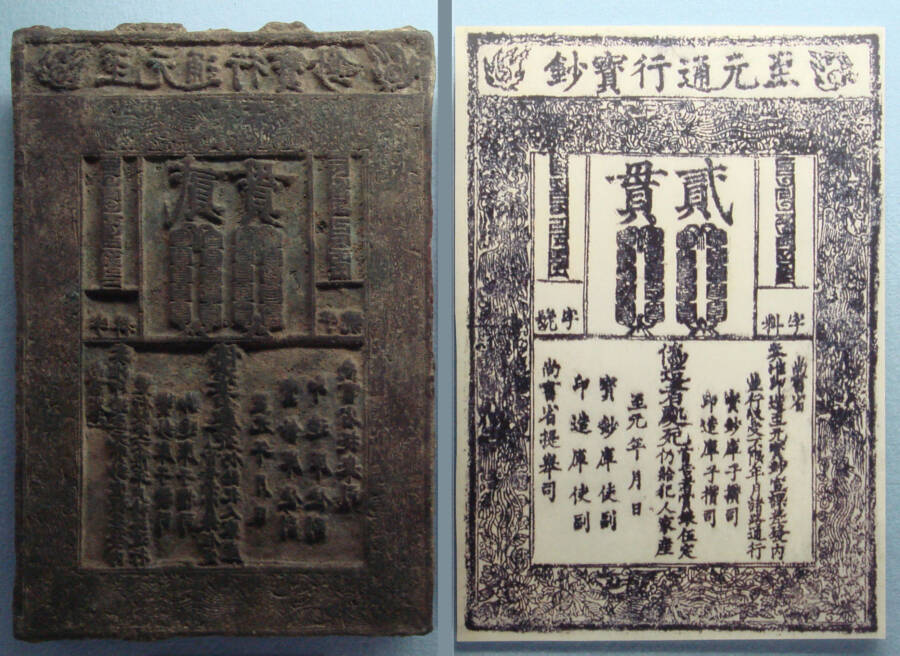
Wikimedia Commons
Yuan Dynasty paper money, called the Jiaochao, with printing plate from 1287.
Despite the brutality of the Mongol conquests, Kublai Khan’s reforms allowed for the spread of new technologies and culture.
In 1269, Kublai Khan ordered that a universal alphabet be developed to replace the imperfect Mongol Uighur script that had been created under Genghis with the intent that it would be used by all the different peoples under his dominion, thereby uniting him under his reign.
Travel throughout Asia was now safe in what some scholars refer to as the Pax Mongolica, or the Mongolian time of peace. Trade flourished. Kublai Khan proved himself to be a relatively enlightened ruler. Foreign visitors often came to the court of the Great Khan and were awed. The most notable of these visitors was the famous Venetian Marco Polo, who came to Xanadu in 1275.
Polo was impressed at the use of paper money which Kublai introduced in 1260 with a threat of death to counterfeiters. His expansion of the canals and funding of infrastructure like a solid road system facilitated the spread of his messages and power across the Empire.
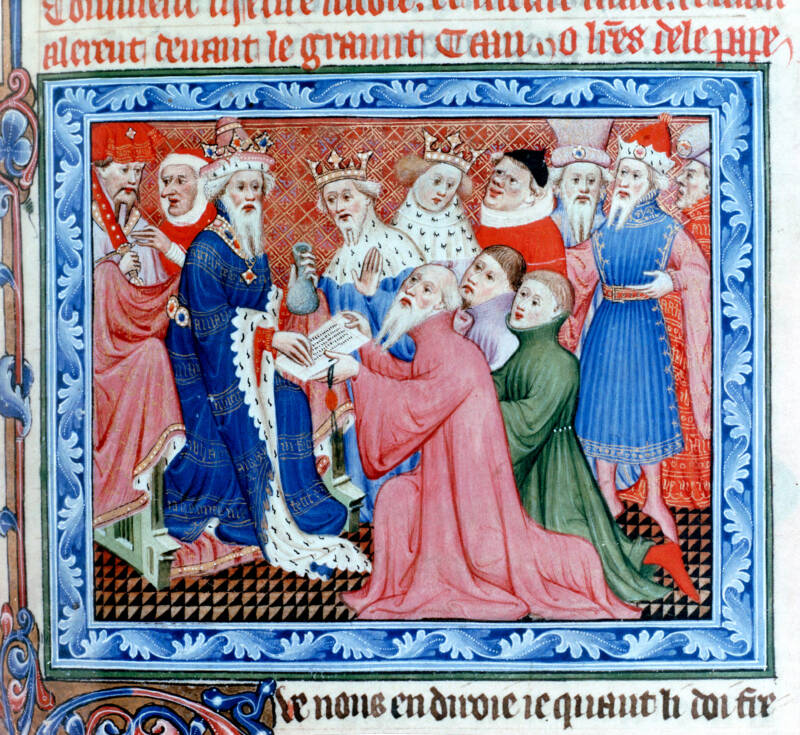
Ann Ronan Pictures/Print Collector/Getty ImagesMarco Polo meets Kublai Khan together with his father and uncle, and presents the Khan of Khans with a letter from none other than the Pope.
Marco Polo also found curious the Mongols religious tolerance which was somewhat unheard of in Europe. Polo recalled Kublai stating that, “There are prophets who are worshipped and to whom everybody does reverence. The Christians say their god was Jesus Christ; the Saracens, Mohammed; the Jews, Moses; and the idolaters Sakamuni Borhan…and I do honor and reverence to all four, that is to him who is the greatest in heaven and more true, and him I pray to help me.”
Marco Polo served Kublai Khan for 16 years in a variety of diplomatic and administrative posts.
Failed Conquests
The effort to separate the Mongols from the Chinese they had conquered was doomed to fail. Although Kublai preferred to use non-Chinese advisers and definitely avoided employing the southern Chinese, he was still increasingly reliant on Chinese advisers through his reign.
What is more, Kublai Khan had to at least superficially take up the trappings of a Chinese emperor. Whether he liked it or not, those things that made the Mongols successful conquerors, like nomadic cavalry and tribal culture, needed to be modified when they settled down to rule. The Mongols were slowly being transformed into the sedentary civilizations that they had conquered.
So what is a Great Khan of Khans to do? The answer seemed to have been to conquer more.
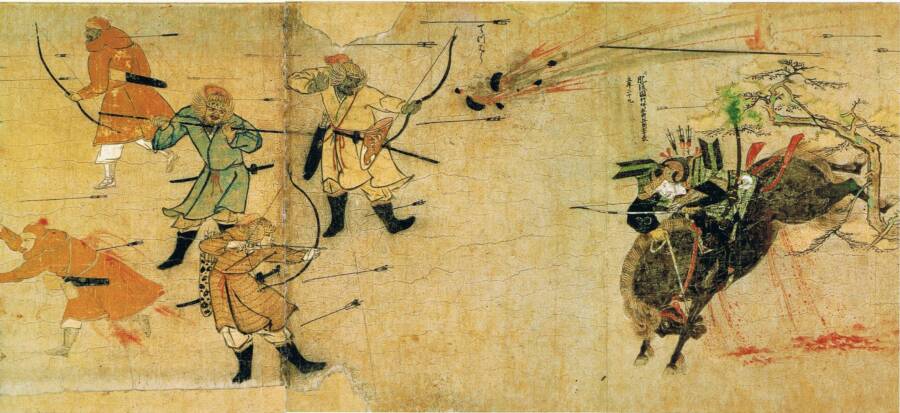
Wikimedia CommonsA Japanese samurai fighting Mongols circa 1293.
Kublai Khan launched invasions into Southeast Asia. There he succeeded in taking Vietnam, Burma, and Sakhalin tributary states, but he failed to incorporate them into the empire. The costs of these campaigns were far more expensive than the tribute gained.
More famous still were Kublai Khan’s two attempted invasions of Japan. The first may have been a reconnaissance-in-force considering that the Khan of Khans sent no more than 40,000 men in 1274. They established a beachhead but did not move inland, opting to withdraw. When they did pull back a typhoon destroyed a third of the Mongol fleet.
The regent of the Shogun of Japan, Hojo Tokimune, realized that it was only a matter of time before the Mongols returned and he thus started to prepare sea fortifications.
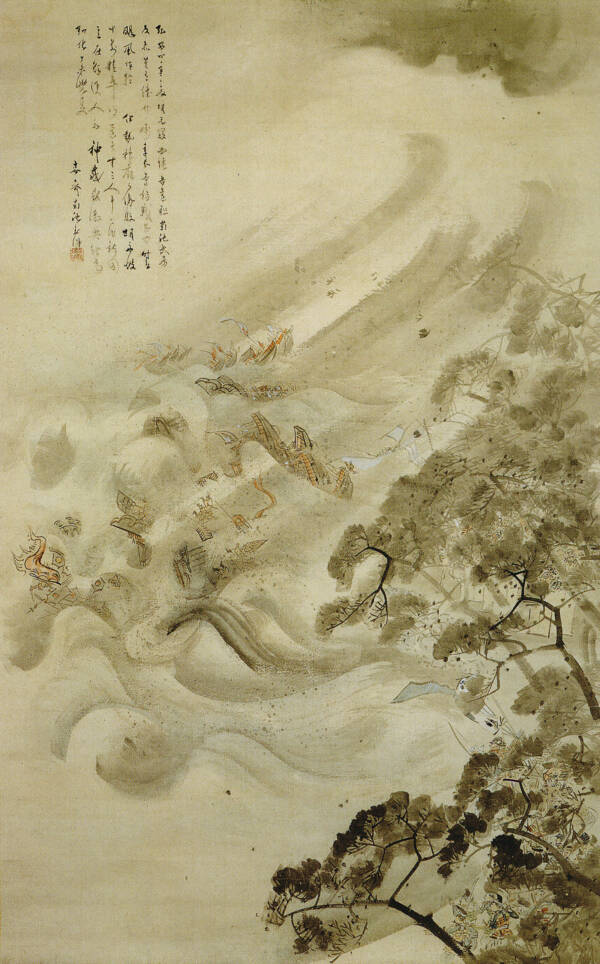
Wikimedia CommonsThe Mongol fleet destroyed in a typhoon, by Kikuchi Yōsai, 1847.
Kublai repeatedly sent envoys to Japan but none of these were able to land ashore. Finally, ten ambassadors arrived at Nagato and refused to leave without an audience with the Shogun. Hojo Tokimune executed them for their impertinence.
Kublai Khan responded by sending an army of approximately 100,000 to subdue Japan in 1281. But the Mongols met stiff resistance between the sea fortifications and a second typhoon which destroyed most of the Mongol fleet and killed between half to two-thirds of their men.
Any Mongols that washed ashore were quickly executed. Only a few Song Chinese were spared. This event ultimately contributed to the fall of the Mongol Empire.
The storms of 1274 and 1281 were reverently incorporated into Japanese collective memory as the legendary kamikaze, or “divine winds.” Not only would these storms become a cornerstone of Japanese art, but the term would reappear during World War II to refer to suicide pilots.
Defeat And Death
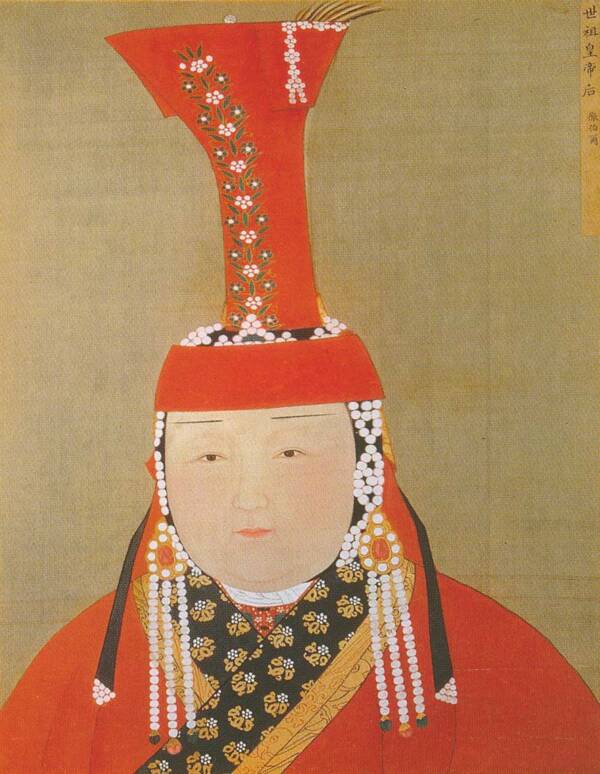
Wikimedia CommonsEmpress Chabi, the beloved wife of Kublai Khan.
The last years of the Kublai Khan were sad ones. His favorite wife Chabi died in 1281 and so did his second son and selected heir Zhenjin in 1284. These familial losses and the defeats in Japan haunted the Khagan. Kublai Khan became withdrawn and depressed which he self-medicated with drink and food. By the end, the Great Khan had become morbidly obese.
In a last hurrah or final bid for triumph, Kublai Khan launched an expedition against the island of Java in 1293. The local king there took offense when the Mongol envoy demanded tribute. He had the diplomat’s face branded. Kublai Khan sent up to 30,000 men to the island, but the tropics were no place to fight for Mongol horsemen and they met defeat.
Kublai Khan was planning another expedition against Java but it was not to be. He died on Feb. 18, 1294, at age 79. By the time he died, his empire had begun to splinter between Mongolian traditionalists and embittered, lower-class Chinese. The Yuan Dynasty proved to be short-lived and was overthrown by the Ming Dynasty in 1368 and Xanadu destroyed.
Like his predecessors, Kublai Khan was buried in the secret burial ground of the Khans, the location of which remains unknown even today, although many have tried to find it.
After this look at Kublai Khan, check out these disturbing murals inside a Chinese tomb from the days of Mongol rule. Then, discover this mass grave of some 300 Russians slaughtered by the Mongols.






